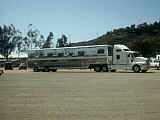|
RULES OF THE ROAD IN HAULING
** Safety
of You and Your Horse **

Once you are ready to hit the road with your horse(s), what do you take pack-along to insure everyone's safety:
1) Firearm? Chemical Spray?
2) Mobil phone? CB Radio?
3) Extra reflective strips on trailer? Road flares?
4) Medications for emergency use: Banamine, Bute, Ace?
5) Leave a route plan with family/friends? Establish a check-in time/day?
6) Have telephone numbers for contacts along the way for rescue units/organizations to help if necessary in an emergency situation?
7) Ever been on a trip, had a problem - and needed something that you had plenty of at home, but just never thought about bringing on a road trip? What was it? How did you work around it?
8) AOL Members: Share your travel experiences with us...good and bad. We can all learn from both.
And read on - on the other side of this column is an excellent article prepared for us by an expert who has traveled many-a-mile with
many-a-horse(s).

* Visit our
Equine Sports
|
EXPERT ADVICE ON TRUCKS, TRAILERS AND TRANSPORTING
1. Determine the size of trailer you need. Available are anything from small one-horse trailers to air ride 15 horse vans. I don't recommend the one-horse trailer as it is too limiting, and the 15 horse type is very costly.
2. Straight Load or Slant. I prefer the slant load. Horses seem to balance better. There is less stress on the front legs and horses are typically easier to unload, as you can turn around and walk out, rather than backing out.
3. Ramp or Step-up. I prefer the ramp, particularly when shipping babies or horses who are not used to loading.
4. Hitches: Gooseneck or Bumper Pull. Goosenecks attach to the bed of a flat bed or pickup truck. This distributes the weight more evenly on the truck and allows a smoother more stable ride. When towing a bumper pull, sway bars or weight distribution bars are helpful.
5. Inside Height. I always get the tallest trailer possible. Plenty of headroom makes the horses more comfortable. My 3 horse trailer is 7'6" inside and the big vans are 10' tall in the center section.
6. Width. I recommend the widest trailer possible. 8' wide trailers position the wheel wells on the inside of the trailer, but if the wheel well is padded, the extra space is well worth it.
7. Tack Room/Dressing Room. If the tack room takes away from horse space, I would recommend against it. If you buy a trailer which is long enough to have ample horse space in addition to the tack room, this is a nice choice.
8. Weight. I prefer heavier trailers. The heavier trailer does cause the towing vehicle to use more fuel, but is more stable on the road. This is a very subjective choice.
9. Towing vehicles. Nothing is more stable than a tractor-trailer combination, but not too many people care to drive a Kenworth truck around! Pickups with 3/4 ton or heavier suspension are fine for medium duty towing. For anything larger than a 4 horse trailer, the one ton "dually" configuration is more stable.
10. Flying. There is no faster way to get your horse from one point to another. Make sure the agent you have handling arrangements is knowledgeable and has contacts at both the take off and destination points.
|